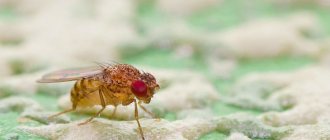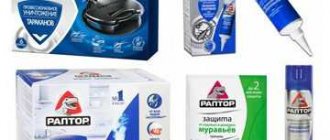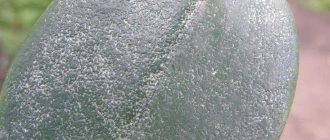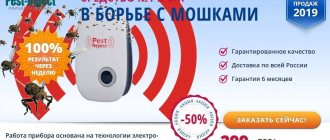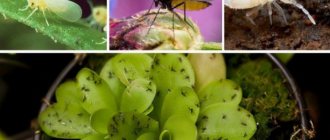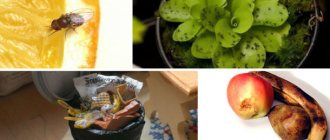As the harvest season begins, many are looking for a way to get rid of fruit gnats. These small annoying insects do not cause serious harm, but they can spoil food and nerves. There are many ways to combat these pests: poisonous sprays, traps, a rich arsenal of folk remedies. Let's find out how insects get into the house, what to do to prevent their appearance, and how to remove fruit flies from an apartment or private house.
Where do insects come from in the kitchen?
The fruit midge is a small black or brown insect that, like the house moss, belongs to the order Diptera. These insects feed on plant fruits that have begun to deteriorate and rotting plant matter. On warm summer days, they can appear in the kitchen, starting in a bag of fruit or in a trash can. To fight these insects, you need to understand where they come from and how they get into the house.
Even the cleanest home is not immune from infection with fruit flies. Flies appear from eggs laid by adult insects on fruits while they are still ripening. Then the fruits are picked, brought into the house and stored, forgetting to wash. There is now enough heat for the rotting process to begin. The eggs will then hatch into larvae to feed on the rotting mass and develop into adult flies.
There are other ways of infection:
- Invasion of flies from the yard through a window or ventilation ducts. This path is especially relevant for private houses. If there are apple trees or other fruit trees in the yard, it is necessary to promptly remove rotting fruits from under them. Otherwise, fruit flies will appear on the rotting remains and fly into the home in search of food.
- Insects enter the house along with contaminated soil. Flower pots are often where midges appear. Soil that has been fertilized with humus is especially dangerous.
To avoid the proliferation of fruit flies in flower pots, do not use “spent” tea leaves to feed plants. Rotting tea leaves are an attractive environment for insects to appear.
Knowing the ways in which midges enter your home, it is easier to organize effective prevention of infection.
Tips and tricks
- Take 100 grams of milk and 2 teaspoons of sugar, 1 tsp. pepper Soak toilet paper in this mixture and place it on a saucer.
- Place a piece of rye bread in a plate and pour the following solution over it : 3 tbsp. spoons of milk, 4 tsp. baking soda and ½ tsp. formaldehyde.
- Place a napkin soaked in 10 g of honey and 1 g of saccharin on the windowsill.
- Stick a match into the flower pot , sulfur into the soil, the fruit flies will die.
- An ultrasonic trap and cleaning the room with ultraviolet light , with a frequency of use once every 7 days, help a lot.
- Leave the kombucha overnight.
- Caught flies must be placed in the freezer for a while ; they die instantly.
- In order not to throw away the glass jar with flies , you can place them in the microwave and turn them on for one minute (power 600). The flies die, and wash the dishes thoroughly with detergent.
- Mix apple cider vinegar with water and detergent and pour into a jar. Leave for several hours. Vinegar strongly attracts insects, and detergent will not allow them to get out. Renew the solution periodically (once every 7 days).
- Place the raptor plate in a sunny place. When heated, a pungent odor will be released, which is poisonous to fruit flies.
- Put the remaining horseradish in the bag , the midges will all disappear.
There are many and quite simple methods of dealing with uninvited guests. Choose what you like.
Preventing the appearance of fruit flies
To prevent a whole swarm of annoying midges from appearing in your apartment, you need to make it as unattractive as possible for insects as a breeding place. The following measures will help with this:
- Destruction of food supply. The trash can must be tightly closed with a lid and removed promptly. Any fruit that has begun to spoil should be thrown away without any pity - or the spoiled parts should be removed. Also, preventive measures include timely removal of food from the table, proper storage of flour and cereals (closed containers, timely disposal of spoiled foods, etc.).
- Elimination of water sources. Like other pests, fruit flies need a source of moisture. A leaking faucet, a dripping pipe joint, or even a constantly damp cleaning rag will do the trick. Remove all sources of liquid and your home will become much less attractive to midges.
- Maintaining good hygiene. Before storing fruits and berries brought into the house, they must be washed to remove insect eggs from them. Then the fruits are dried and placed in plastic bags. In addition, important preventive measures are wet cleaning, garbage disposal, and timely washing of dishes.
- Blocking access from the street. All opening windows are covered with mosquito nets. Mesh screens are also placed on ventilation vents.
We recommend: How to wash kitchen towels at home - 3 proven methods
Following these rules will help protect your home from fruit flies entering your home. If an infestation is discovered, it is necessary to take urgent measures: find a place where flies are hatching (usually a can of cereal, a bag of rotten fruit or a flower pot) and carefully dispose of spoiled food along with the flies.
Fruit flies: who are they?
Fruit flies (also called fruit flies, vinegar flies, wine flies), Drosophila (drosophila) melanogaster, are a small black flying insect 2-3 mm in size.
Intrusive insects feed on the juice of fruits and plants, giving preference to rotten parts. This is where the flies lay their eggs, from which the larvae hatch.
The reproduction process in Drosophila is very fast:
- one female lays from two hundred to one and a half thousand eggs;
- in just 10 days, the larva from the laid egg will become an independent adult insect.
Therefore, it is necessary to take measures to remove fruit flies from housing immediately.
What and how to seal the gap between the bathtub and the wall to prevent water from leaking? We have the answer!
Read useful tips on how to keep cucumbers fresh longer at this address.
Why are fruit flies dangerous?
Attitudes towards fruit flies range from complete disdain to unjustified fear. They are practically safe for humans: they do not bite and do not cause allergies. But the appearance of these insects in the house has several harmful consequences:
- Flies carry the remains of rotten fruit along with bacteria on their legs. Once in food, these bacteria multiply quickly, which leads to food spoilage. Rotten products accumulated in spoiled food can cause food poisoning.
- An annoying midge, flickering in front of the face, landing on the skin, crawling into the eyes and nose, can quickly drive even the most patient person to white heat. Since fruit flies do not feed on blood, humans are not particularly attracted to these insects. But with a strong infestation, the intrusiveness of fruit flies already turns into a problem.
The fruit fly is a popular subject for study in genetics. Thanks to her, many fundamental laws of nature were discovered. But outside the scientific laboratory, this insect does more harm than good.
Despite the relative harmlessness of Drosophila, you should not hesitate to start the fight. The more time passes from the moment the infestation is discovered, the greater the hordes of flies you will have to fight.
Mechanical methods
The action of some products requires a certain period of time and the insects, accordingly, will disappear gradually. Not everyone wants to use chemicals. Those who can no longer tolerate the presence of midges and want to get rid of them as quickly as possible (this may be most of the swarm) should try the following methods:
Vacuum cleaner
Household appliances are always a reliable assistant in the home. Therefore, many consider a vacuum cleaner an effective means of combating midges. Although they can only collect a large cluster of midges, and even then, some will still run away, and the next day they will have to hunt for the next “batch.” Nevertheless, portable vacuum cleaners are quite popular - I tracked down insects, caught a few and it became easier - at least some of the pests were destroyed. To increase the number of pests caught, you must first set a bait that will gather a large swarm around itself, and then turn on the vacuum cleaner at full power.
Hydration
With the help of a spray bottle, you can indeed moisten the wings of insects and the latter will not be able to fly. This method works, but has several nuances. You immediately need to think about where to quickly remove the midges, and, secondly, correctly calculate the degree of moisture, so that later you do not have to fight the flood.
Ventilation
Ventilation of the apartment must be carried out regularly and without fail. Good air circulation will prevent the appearance of unpleasant odors and excess dampness. Through ventilation can remove a considerable amount of midges from the house.
Smoking
The method is based on insects’ intolerance to strong specific odors. There are several options, but before using each of them, you need to make sure that no one in the house is allergic to the components used.
- Camphor in a frying pan
To make camphor work and release the characteristic smell of wormwood, you need to pour the powder into a well-heated frying pan. With such an amazing scent, you can go around all the rooms or leave it until it cools down in the room with the highest “concentration” of midges. In the absence of camphor, clove oil or verbena will be no less effective.
- Incense
The phrase “he’s as afraid as the devil of incense” can easily be applied to midges. Fumigation will force insects to quickly and permanently leave the occupied territory. There is no incense - it’s also not a problem; you can safely take sprigs of thyme, pine or juniper for burning.
Mosquito nets
It seems like I installed a mosquito net and not a single insect will penetrate the house, but they break through even such protection. It's all about the cell size (from 0.6 to 1.2 mm) and it cannot always stop midges.
Then additional protection is applied:
- The “old-fashioned” way is to buy the most inexpensive nylon tights, cut them and add another layer of mesh.
- Chemical repellents are sprays that can be applied to the mesh, and they will repel midges.
- Natural helpers - vanillin dissolved in vodka or water, sprayed over a mesh from a spray bottle, and essential oils of eucalyptus, lemon balm, lemon or tea tree are applied using a cotton swab. After such treatment, you can be calm - not a single midge will get into the apartment.
The best household chemicals to combat midges
The chemical industry produces many varieties of insecticides and insect repellents. Some of them can also be used to combat fruit flies.
Here are some of the most effective drugs:
- Liquid for fumigator "Kombat". The reservoir with liquid is screwed to the fumigator, then the device is connected to the power supply. The fumigator releases vapors that have an insecticidal effect. In addition to midges, the drug will get rid of mosquitoes and flies. The product acts quickly (the effect is noticeable within an hour) and is affordable. A bottle of liquid costs about 300 rubles.
- Raptor trap with sticky inside. A bait solution is supplied with the trap. It is enough to pour a small amount of solution into the trap and place it in a place where insects accumulate. One trap is enough to effectively protect a room of 10 square meters. m for a month. At the same time, the outside of the trap remains clean and does not spoil the interior of the kitchen. The price of the set is about 150 rubles.
- Aerosol "Dichlorvos". A powerful, effective insecticide containing cypermethrin and tetramethrin. In most cases, a single treatment is enough to get rid of fruit flies. However, the product is not safe for health - after spraying and exposure, the room must be thoroughly ventilated.
We recommend: Dichlorvos neo odorless: instructions for use
Kitchen cleaning requires special care to ensure that the insecticide does not get into drinking water or food. Before spraying, place all products in tightly closed containers and hide them in a closet. Flowers and pets are also removed from the kitchen, and children and elderly family members are prohibited from entering the premises during treatment.
Reasons for appearing in a person’s home
Drosophila are found very often in an apartment or residential building. Popular places of their settlement:
- flower pots with waterlogged soil (overwatering causes the roots and stems of houseplants to rot);
- rotten vegetables and fruits that were not disposed of in a timely manner;
- supplies in the pantry - fruit flies infest cereals and nuts;
- A trash can that is not emptied every day is rarely washed.
READ ALSO: How to get rid of mosquitoes in an apartment: aerosols, traps, repellers, fumigators and folk remedies
Often flies are found in boxes of onions, zucchini or pumpkins stored in the closet, bags of potatoes or beets. It is enough to rot one fruit in a bag for fruit flies to choose this source of food and reproduction.
One of the names - wine fly - was given to Drosophila for its special love for wine smells and fermented food products. Carelessly forgotten and sour jam or compote in an open jar will certainly become a breeding ground for insects. For this reason, it is unacceptable to store empty, unwashed alcohol bottles at home.
Folk remedies: cheap and safe
The use of industrial insecticides is justified as “heavy artillery” - as a last resort in case of severe infestation. In other cases, it is better to use safer folk remedies:
- Smelling foods have a good effect in the fight against fruit flies: garlic, cloves, orange peel, vinegar.
- Indoor plants that emit strong odors, such as geraniums, will help.
- Another helper is tape with an adhesive surface.
- A homemade poisonous composition gives a good effect: half a glass of milk, 40 g of sugar, 40 g of black pepper. Saucers with the solution are placed in places where flies accumulate.
We recommend: Tired of the household routine - what to do with the “housewife crisis”?
Often these products are sufficient to combat fruit flies.
How to remove fruit flies using traditional methods
A good remedy against these insects is ordinary table vinegar. To do this, all cabinets and shelves for storing food are washed with soapy water. Then all surfaces are wiped with a solution of table vinegar. Additionally, strong-smelling substances are placed in areas where fruit flies accumulate. Garlic cloves, orange peels, and lavender leaves are suitable for this.
Camphor aroma works well against fruit flies. Camphor is crushed into pieces and fried in a dry frying pan. When smoke starts, remove the container from the heat and carry it through all the rooms. In rooms where flies accumulate more than other rooms, it is worth staying longer. Camphor is not dangerous for people and animals. Therefore, there is no need to remove anyone from the apartment before such treatment.
How to make a trap with your own hands?
You can make an effective fruit gnat trap yourself. Place a piece of apple, apricot or other sweet bait at the bottom of the glass jar. A sheet of paper folded into a funnel is inserted into the neck; a hole with a diameter of 3 mm should remain in its lower part). The flies will begin to make their way into the jar towards the bait, but will no longer be able to get out.
Getting rid of a brood of fruit flies is quite simple. The main thing is to notice the infection in time and take action quickly. Then the insects can be defeated using homemade traps or folk remedies. And, of course, do not forget about prevention. Throw away rotten fruits in a timely manner, do not forget about cleaning - and fruit flies will not become a problem for your home!
How to get rid of eggs
Since adult insects lay eggs on ripe fruits, getting rid of them is quite simple:
- Wash the brought fruits or vegetables thoroughly under the tap.
- Next, pour boiling water over them.
- All vegetables and fruits must be kept in the refrigerator, since the reproduction process does not occur here.
It is a little more difficult to get rid of midge eggs from indoor plants:
- The flower from the pot should be replanted.
- The leaves should be wiped with soapy water or alcohol.
- Next, the soil changes. It is good to use a purchased substrate. It is specially treated against all kinds of parasites.
- When using soil from planting, you need to do your own preventative measures.
- Place the soil on a tray and put it in the oven for a couple of hours.
- All parasites in the soil will die during this period.
- Plants are treated with a floral remedy against midges.
- Rotten roots are cut off.
- Next, prepare a warm solution with potassium permanganate, into which the plant is lowered for a few minutes. A weak concentration is used.
- Then plant the flower in a pot. All fruit fly eggs will be destroyed.
- When further caring for the plant, do not forget to loosen the soil and monitor excess moisture.
Midge: from and to
How does a midge develop and where does it come from? It develops in about a day and lives only five days. The female of this insect lays about 400 eggs in the environment of rotten fruits standing in a vase on the table.
The eggs begin to open after 24 hours. The larvae grow for five days and during this time they molt twice: 24 and 48 hours after their birth. The larvae are then sealed into a puparium and undergo a metamorphosis stage of five days, after which they develop into adults.
And then the owner looks, and a whole swarm of midges is already hovering over this vase. The only good thing in this case is that the midges do not grow to a large size. But all this does not make them attractive.
LiveInternetLiveInternet
Drosophila (fruit flies, fruit flies) can hardly be called a direct enemy of humans.
They do not directly harm people’s health and lives.
Rather, they are the enemies of fruits and vegetables, food warehouses, shops and inexpensive cafes. However, they can seriously annoy any connoisseur of country holidays and even city dwellers. Anyone who has encountered these small, strange insects knows that it is not so easy to get them to leave the house. Plus, it’s never clear where they come from!
Today we’ll talk about how to get rid of midges in an apartment.
How to distinguish fruit flies from other midges?
People often don't know how to distinguish fruit midges from sewer midges, flower flies and other insects. Some even believe that these are all the same creatures. In fact, there is a difference. It lies in the degree of danger of insects, their habitats, the rate of reproduction, as well as the “favorite dishes” of these creatures:
✔ If flies fly out of your kitchen or bathroom sink, then these are sewer flies (flies). They appear “fluffy” due to the dark hairs with which their bodies and wings are densely covered. ✔ If you notice that small flies are swarming in your indoor flowers, and the plants themselves have begun to wither, the culprit is flower midges (sciarids) .
If fruit flies are infested in a potted houseplant, allow the soil to dry completely between waterings. This will kill most of the larvae, but the adults do not live long and will soon disappear. And then spill the soil with a weak solution of potassium permanganate. You can also spray the plants with the same barely pink solution of potassium permanganate from a spray bottle. You can sprinkle the soil in the pot with black pepper - flies are afraid of it. Another folk remedy is to stick matches into the soil with the sulfur heads facing down . Remember that small flies love organic fertilizers , so do not use them on your house flowers. If you cannot get rid of insects in flowers using improvised means, use special products sold in stores.
Flies do not like the smell of geranium, so it is worth keeping a pot of geranium on the kitchen windowsill. It will not only delight you with large and beautiful inflorescences, but will also be an excellent preventative against the appearance of small flies in the kitchen. How to distinguish them? Flower midges are more like black mosquitoes, and fruit midges are more like small flies.
✔ If flies have settled and multiplied on spoiled fruits and vegetables, fly over fermented alcohol or sweets, then these are precisely fruit flies - fruit flies and also otherwise called fruit flies. We will look in detail at how to get rid of them in this post. The fruit midge is one of the most harmless creatures on this list. It is classified as an insect that is not dangerous to humans. It's just that she multiplies too quickly.
The presence of a fruit fly in the kitchen does not evoke the most pleasant emotions. The appearance of a swarm of flies within the kitchen or other premises becomes a problem for owners who dream of how to remove them from the house and how to get rid of the annoying small flies swarming over food waste near the trash can or in other places where they find food. In addition, the female uses rotting fruits as a “cradle” for the development and nutrition of future offspring. And although the tiny fruit fly itself does not pose a significant danger, it can act as a carrier of various infections. The fruit fly is a representative of small insects of the order Diptera, a family of fruit flies (Drosophilidae), which includes about 2000 species. They are ubiquitous, so almost all people have encountered these creatures in one way or another. They can be recognized by their oval, bulbous body and slow, “drunk” flight.
Most representatives of this family are synanthropes and live exclusively near human settlements. Adults feed on flower nectar, plant juices and rotting organic waste. Drosophila has the smallest size (the average length of the body is 1.5-3 mm). Long wings, yellow-brown body color with thin black rings and red eyes on a spherical head (which can only be seen under a microscope or in an enlarged photo of a fruit fly).
Females are larger in size than males, and males are also distinguished by their darker rear part and the shape of their abdomen. In females it is round and has a pointed tip, while in males it is cylindrical with a blunt end. Females have more chitinous plates and 8 dorsal setae (tergites) on their abdomen; in males, 6 and 8 are fused together and form the genitals, which also include a special comb on the 1st segment of the front legs.
Differences between males and females can vary and are directly dependent on living conditions and diet.
By the way, there is a study that suggests that male fruit flies, who are deprived of their attention by females, find “comfort” in alcohol. They prefer foods containing ethanol - while their happier comrades are completely indifferent to such foods.
Where do fruit flies come from in the house?
Fruit flies feed on tree sap and vegetables, with a preference for fermentable fruits. Therefore, in southern countries, fruit flies live in large numbers in gardens where fruits and grapes are grown. However, no one fights them there, because flies do not cause significant harm to crops and plants, and are also completely harmless to humans.
Many housewives are surprised and ask the question: where can fruit flies come from in the kitchen? During the summer months, rukti flies are known to lay their eggs on healthy fruit before it is even picked and sent to store shelves. Therefore, you should not be surprised that as soon as food begins to rot, these insects appear as if out of thin air. That is, they can appear in any house where the owners bring any fruits for consumption.
The lifespan of flies depends on the ambient temperature: at a temperature of +25°C, an insect can live for about 10 days, and when it drops to +18°C, this period is extended by 3 times. In winter, when temperatures drop, flies can live for about 2.5 months.
Flies reproduce with the help of eggs laid by females, with a clutch of 50-80 pieces. they can also do it in a semi-liquid medium (rotting parts of fruit), on the surface of which eggs can be held using a float chamber. Their quantity depends on the time of year, temperature and food conditions of life. On average, each female manages to lay about 300 eggs during her life, the size of which does not exceed 0.5 mm.
Drosophila larvae appear within a day after the formation of the clutch and have a worm-like shape, white color and a length of up to 3.5 mm, which then gradually changes.
The duration of the transformation period into adult insects is 10 days.
The main source of nutrition for the larvae is microorganisms that promote the fermentation process; they always live on the surface of the fruit. If necessary, the larvae can dive into the depths and then pupate. After the pupa appears, a young fly emerges from it 4 days later.
According to scientists, there are several thousand species of fruit flies in the world, but only 1529 have been described, of which about 40 live in European countries. Under the natural conditions of Russia, they are more often found in the southern regions, but in the summer months they easily move closer to the north along with transported vegetables and fruits.
The greatest species diversity is observed in hot zones of the tropics and subtropics - for example, on the Hawaiian Islands there are about 300 species of fruit flies.
♦ Black Drosophila is the most studied species, color is yellow-brown, eyes are red, body size is 2-3 mm. Females are distinguished by dark stripes on their abdomen, in place of which in males there is a dark spot.
♦ Fruit - feeds on plant sap, size 2.5-3.5 mm, with wings - up to 5-6 mm. The color of the body is yellow-brown, the abdomen and chest are yellow, the eyes are red. According to experts, such flies manage to raise 13 generations of their children in one season. Moreover, the life cycle of each individual can vary between 9-27 days.
♦ Flightless Drosophila - differs from other species in having undeveloped wings, so it moves by jumping. These flies were obtained by crossing several species of fruit flies and are distinguished by their “large” size (3 mm) and longer life cycle (up to 1 month). Diet: rotting fruits and vegetables.
♦ Large Drosophila - prefers to live in rooms where fruits are stored, from the rotting parts of which it sucks the juice. It is distinguished by its brown color, the head is yellow-brown. Females lay up to 150 eggs per season, they live all year round, and their lifespan is more than 30 days.
Flies are even attracted to air fresheners if they smell like orange, lemon or cherry. If insects have not yet appeared in your home, it is better not to overdo it with these odors. Otherwise they will definitely arrive.
How to deal with fruit flies in the house?
These insects do not like excessive attention and prefer shaded and damp places hidden from human sight. Fruit flies are most active at dawn and dusk. They are not able to move long distances, because they can fly no more than 180 meters per day. As already noted, their distribution occurs along with transported products in which they lay their eggs.
The most important trump card in the fight against fruit flies is cleanliness. The appearance of minor foci of activity of these insects is eliminated once or twice. The main thing is to find the source of their spread and destroy it. But if the midge lives in your house permanently, then you need to resort to a whole extermination system. It combines preventive measures and cleaning methods.
Here are a few points that are included in this “system”: ✔ The fight against fruit flies should begin with finding and eliminating possible sources of their appearance. It is necessary to throw away all rotting food and any food debris that could serve as a breeding ground for them. ✔ Any place where there is food and moisture can attract insects. In general, if you can’t find the source, look for it in non-obvious places. Here are some search tips:
— If you keep compost for indoor plants in the kitchen, then you should take a closer look at it. — When was the last time you cleaned a trash can? Even if you throw away your trash bag regularly, the container itself can be a source of problems. - Sometimes the cause of midges can be a sweet liquid that has flowed into the base of the headset, kitchen drawer, under the refrigerator or other places. — Mushrooms, cereals and cheeses are far from fruits and vegetables, but even the midges do not disdain them.
Take regular measures to prevent the appearance of flies in your home.
✔ Do not leave dirty dishes in the sink; periodically check bags of vegetables and fruits for rotten stock. Store fruits and vegetables in airtight containers or in the refrigerator.
✔ If you have pets in your home, you need to thoroughly clean their bowls after every meal.
✔ Any sweetish, sour or wine-like liquid in an open vessel or vessel is the best bait for midges. Wash glasses after drinking juices, plates with leftover honey, and seal wine bottles tightly.
✔ Regularly wash the rags you use for wiping dishes and wiping washed fruits. Wash the floor cloth. Keep your kitchen counter free of crumbs, sticky stains, and any dirt. Remember about gas stoves: their surfaces need to be scrubbed with a special cleaner at least once a week. Take out the trash from your home regularly!!! On the second or third day you already find yourself in the risk zone. Especially in summer and autumn.
But what should you do if the fruit flies got to the fruit bowl faster than you? If annoying insects have taken up residence in your home, these unwanted guests are unlikely to leave voluntarily. Luckily, there are a few simple steps you can take to get rid of fruit flies.
We set traps
Traps with funnels and baits are a simple folk method that works 100%. Perhaps this is the most effective way to catch a large number of flies at once. The principle of operation is simple - the flies are lured into a container with a small hole by the smell of bait, and cannot fly back out. If you leave such a trap in the kitchen in the evening, in the morning you will find a whole swarm of insects inside it.
Perhaps this is the most effective way to catch a large number of flies at once. The principle of operation is simple - the flies are lured into a container with a small hole by the smell of bait, and cannot fly back out. If you leave such a trap in the kitchen in the evening, in the morning you will find a whole swarm of insects inside it.
How to make a trap:
- Take a glass jar, vase or any other container with high walls and place/pour bait into its bottom, for example: - Berries or a slice of fruit, say a pear or banana. - A couple of spoons of jam. - A little apple cider vinegar.
- Roll an A4 sheet or any other paper into a cone, secure the tip with tape and cut it if necessary, then insert the resulting funnel into the jar with the narrow side down. The tip of the funnel should not touch the bait.
- Place one or a couple of these traps in high-risk areas - for example, near a sink, trash can, flower pot, if there are fruit flies there.
- Hopefully you will see that the flies like your bait. If there are no flies in the trap, try using a different bait.
- After a few hours, pour warm soapy water into the jar (without removing the funnel!) to drown the caught insects. Keep the solution in the jar for a couple of minutes and then pour out the contents.
- If you cannot catch all the fruit flies at once, repeat the procedure until the trap is empty.
- In addition, we recommend repeating the procedure 8-10 days after a positive result, because a “new generation” of midges can grow from the eggs remaining somewhere.
The photo below shows other types of traps with the same principle of operation. As you can see, instead of a paper funnel, you can use a kitchen funnel or cling film perforated with a toothpick (a cellophane bag will also work) - put bait (pieces of fruit, juice or even beer) in the container, cover the glass with film, make several holes in it - the flies will come to feast on it and they won't be able to get out...
You can also use an ordinary open beer or wine bottle with the remains of a drink at the bottom - flies will not get out of it either.
By the way, both the jar and the funnel can be made from a plastic bottle. To do this, you need to cut it into two parts, so that the part with the neck is shorter, then insert the resulting funnel into the jar with the neck down and secure the trap with tape.
other methods
Ethyl alcohol 70 or 90% will help quickly kill midges. To do this, you need to pour it into a spray bottle and spray it directly on the flying flies. Adult fruit flies will instantly fall to the floor and all you have to do is sweep the floor. This method is good because alcohol is a safer “insecticide” than special products, and it can also kill eggs.
Another trap option is to pour water into a cup with 2-3 tablespoons of apple cider vinegar, and add a few drops of dishwashing detergent on top. Flies are attracted to the smell of vinegar, and soapy water prevents them from flying away. If you decide to use vinegar, make sure you choose it correctly. White vinegar will not work. Malt and red vinegar will work, but not as well as apple cider vinegar. You can also use balsamic vinegar.
Hanging ribbons in your kitchen probably won't look pretty, but they get the job done. Don't hang ribbons directly over the kitchen sink. Hang them where they won't disturb you.
Use tapes with caution and out of the reach of children.
We use chemicals
If none of the above methods helped or you don’t want to bother with sweet and sticky liquids, or keep rotting fruit in a glass jar in your house, and the question of how to get rid of small flies in the kitchen still remains relevant, you will have to use poisonous substances. This can be any repellent - they are sprayed in the kitchen, removing all open food and drinks from there. You can use the usual Dichlorvos or more modern preparations.
When using chemicals, be sure to remove all products that may be exposed to spray droplets, open containers of water or juice, and pet food and water bowls. There should be no pets or people in the kitchen while spraying chemicals. After treating the room, you must thoroughly wash all kitchen surfaces - cabinets, countertops, household appliances, floors. Be sure to ventilate the room after treatment and after the flies disappear.
It is also worth paying attention to branded traps against fruit midges. The traps also come with a non-toxic liquid chemical. So you can replace it with wine or apple cider vinegar..
Electric fumigators are also effective in combating flies, such as RAPTOR® “Fruit Fly Protection”.
***
What should you do if midges in the kitchen have started to appear in the sink? You can check whether it is a breeding ground for fruit flies like this: stick a piece of cling film coated with a thin layer of honey to the drain, and then return to the sink after an hour. If you see fruit flies stuck in the honey, your sink is part of the problem. To eliminate it, make sure that the drain is working properly, and then pour boiling soap solution into it. Finally, use a brush to scrub down the sides of the drain.
To get rid of insects, you need to periodically use a clog cleaner. If you don’t have such a product on hand, you can pour a little soda into the pipe and then pour vinegar into the drain - you will hear a characteristic hissing sound, after which you need to rinse the drain with water and use a plunger. based on materials from notklop.ru, kitchendecorium.ru,
*** I hope these simple steps will help protect your home not only from fruit flies, but also from other insects.
Interesting! Drosophila are known among genetic scientists, where they are successfully used for experiments and are specially bred. This is due to the fact that the somatic cells of an insect contain 8 chromosomes, which makes it possible to obtain various mutations when breeding fruit flies. According to scientists' observations, when fly cells were exposed to viruses common among humans, in 61% of cases the reaction was similar to that of humans.
In laboratory conditions, scientists breed fruit flies in a special nutrient medium created in a test tube. A favorable substance for them is a mixture of corn flour, yeast, beet syrup and malt additives. When conducting experiments, scientists add special substances to such an environment to cause mutations in flies. Their lifespan in laboratory conditions is almost 2 months, during which they lead a typical fly life: they eat, mate and lay eggs.
Note to the owner:
How to wash kitchen towels
How to save a burnt dish
Shoes not like Cinderella or how to stretch new shoes
About the insect
Drosophila, small flies, breed in fruits. In everyday life they are called fruit or wine. These two-winged insects contributed to the development of biology by serving as a model specimen. In addition, an individual Drosophila visited space on a “scientific mission.”
The life cycle of the insect reaches up to twenty days, depending on the temperature, but rapid reproduction with the ability to lay up to four hundred eggs during this time creates the preconditions for a rapid increase in numbers under favorable conditions. They are even bred specifically for feeding terrarium inhabitants and aquarium fish. Rotten fruit is an ideal place for fruit flies.
What to do if the midge does not disappear after cleaning
If general cleaning does not help, it’s time to take drastic measures and kill the midges using bait traps. A piece of something sweet is placed or poured into a plastic jar, then wrapped in cling film, and pierced in several places with a gypsy needle. The bait is left overnight. Having smelled the aroma, the midges will want to feast on the sweetness, they will penetrate the jar, but will no longer be able to get out. It is better to throw a trap full of insects in the trash.
Another trap option is liquid. Honey, wine or juice, and wine vinegar are poured into a deep plate. They put the peeled fruit there and cover the bait with a plastic bag, in which holes were previously made. Having flown into the trap, the midge will not be able to fly back.
Important! If you find a cluster of flies in your kitchen cabinet, you can spray them with soapy water from a spray bottle. It will prevent the fruit flies from flying away.
Since midges do not like strong and pungent aromas, you can buy aromatic oils. By pouring patchouli, ylang-ylang, lemon, and lime oil into an aroma lamp, you can quickly and easily get rid of the misfortune. On the contrary, sweet and spicy aromas attract fruit flies. Another option is to place chopped garlic or dry bouquets of wormwood, lavender, and tansy in the kitchen. A candle with a pine or spicy scent will also help. You can also use one of the chemicals sold in stores.
Drosophila do not tolerate the aroma of geranium, eucalyptus and myrtle, so you can buy a pot of these plants and hang them in the kitchen. This will not only improve the appearance of the room, but also eliminate the problem: the midge will not be able to live next to the flower. Tomato seedlings have the same repellent effect.
Liquid traps with pieces of fruit are popular among housewives.
Some owners prefer to get rid of midges by hunting for them with a firecracker. It should be remembered: although insects are slow, they are attentive and record fast movements. It's better to move smoothly. An effective way to remove midges from the kitchen is to use a powerful vacuum cleaner. It will “suck” the offspring into itself, but will not get rid of the larvae, so the root cause of the problem will still have to be resolved. Adhesive tape can work against midges if you place bait nearby - a sweet and soft fruit.
Why do fruit flies appear in the house? How are they harmful?
Female and male fruit flies
If there are rotten fruits, berries or vegetables in the apartment, then you are guaranteed to have fruit flies. Since they are heat-loving, insects can be seen more often in the summer. If there is food in an open place, then there is a high probability that, over time, midges will also appear in the house.
Another way midges appear in a house is through ventilation shafts.
You can bring midges along with fruits and vegetables purchased at the store or collected at the dacha.
Of course, when compared with other insects, midges seem harmless and only bother you with their presence. The insect does not bite, does not drink blood, and is not a carrier of serious diseases. But this does not mean that the presence of midges in the house is safe.
Midges lay their eggs in food, and if you eat them, you may suffer from food poisoning.
Drosophila midges also harm indoor plants. It is easy to see the infestation of flowers, but it is difficult to get rid of the insects. Often midges appear in the soil of indoor plants if they have high moisture content. To avoid their appearance, you need to monitor the watering of the plants and, if necessary, reduce it. Another reason for the appearance of midges in indoor plants is the use of folk remedies to fertilize the soil (coffee water, tea leaves). Also be careful when purchasing soil, because stores often sell soil that is already infested with insects.
Midges on fruit: who are they?
Insects are interested in fruits because of the sugar they contain. In apartments in the Central region of Russia, midges hovering around fruits are most often either fruit fruit flies or some type of blood-sucking midges, which are also a component of midges
.
- Fruit flies, according to the official scientific classification, are flies, but their sizes are extremely small - a maximum of 2.5 millimeters in length, which is why they look exactly like midges to the human eye. The insect has a beige-transparent body, sometimes with vague dark stripes or spots, and bright red eyes. Fruit flies
not only feed on fruits, but also lay larvae directly in them. - Midges are forced to drink blood to reproduce, but this only applies to females. Males feed on nectar and sweet liquids, so, like fruit flies, they may well be interested in the fruits laid out on the table and the contents of your garbage can. Midges
do not lay larvae in food containing sugar, but the very contact of insects with food already makes it unsafe.
Despite their size, these insects can cause many problems to humans. Blood-sucking pests are capable of acting as carriers of diseases transmitted through blood at the time of the bite. Eating foods with larvae inside can lead to poisoning and provoke the occurrence of myiases - ailments caused by insects entering the body. Fortunately, to combat small insects hovering over fruit in the house, it is not necessary to determine their species for certain. You can fight them using the same methods, so for convenience, below, the term fruit midges will mean both fruit flies and various types of midges at the same time.
Helpful advice
Midges that swarm around fruits do not always live in them. Check for them in sink, sink or bathtub drains, near hot water pipes and in areas around flower pots. If they are there, pest control will need to be done in these places too.
